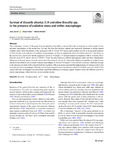2020-05-28Zeitschriftenartikel
Survival of Brucella abortus S19 and other Brucella spp. in the presence of oxidative stress and within macrophages
Jacob, Jens
Finke, Antje
Mielke, Martin
The evolutionary “success” of the genus Brucella depends on the ability to persist both in the environment as well as inside of even activated macrophages of the animal host. For that, the Brucellae produce catalase and superoxide dismutase to defend against oxidative stress. Since the deletion of the mglA gene in the B. abortus S19 vaccine strain resulted not only in an increased tolerance to H2O2 but also in the induction of cytokines in macrophages, we here investigated the effect of oxidative stress (Fe2+ and H2O2) on the survival of B. abortus S19 and the isogenic B. abortus S 19 ∆mglA 3.14 deletion mutant in comparison with B. neotomae 5K33, Brucella strain 83/13, and B. microti CCM4915. These Brucellae belong to different phylogenetic clades and show characteristic differences in the mgl-operon. From the various Brucellae tested, B. abortus S19 showed the highest susceptibility to oxidative stress and the lowest ability to survive inside of murine macrophages. B. abortus S19 ∆mglA 3.14 as well as B. neotomae, which also belongs to the classical core clade of Brucella and lacks the regulators of the mgl-operon, presented the highest degree of tolerance to H2O2 but not in the survival in macrophages. The latter was most pronounced in case of an infection with B. 83/13 and B. microti CCM4915. The various Brucellae investigated here demonstrate significant differences in tolerance against oxidative stress and different survival in murine macrophages, which, however, do not correlate directly.
Dateien zu dieser Publikation

